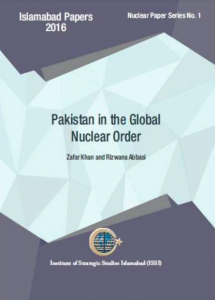-Zafar Khan and Rizwana Abbasi, Islamabad, Pakistan
The term ―recessed deterrence was coined for India by Jasjit Singh and was later elaborated in Ashley Tellis‘s work in 2001 explaining what India‘s nuclear strategy would be after it tested its nuclear weapons in its May 1998 nuclear tests. George Perkovich called it ―non-weaponized deterrence.

The aim of this type of nuclear strategy is ―non-deployment prohibiting the mating of weapons with delivery systems and maintenance of readiness at low level, but other plans, procedures and organizational mechanisms for deterrence strategy remain intact. A nuclear weapons state can establish a particular ―encapsulated and/or ―canisterized mechanism that can enable the state to pre-mate warheads with delivery system. Some deterrence forces can be kept at recessed position while others can be readily deployed for deterrence purposes. Still other deterrent forces that remain in the recessed form could quickly be mated when and if the security establishment would deem it necessary to deploy them. However, neither all deterrence forces can be recessed nor deployed as ready arsenals. Deterrence stability may be retained in both forms under a centralized command and control mechanism. Most importantly, a nuclear weapons state would need to carefully assess the prevailing strategic environment and make sure that the strategic deterrence is not undermined either by recessed or deployed nuclear strategy.
Although Dalton and Krepon, authors of the Carnegie Stimson report, propose that Pakistan practice recessed deterrence so that India follows suit, theirs is not a holistic approach. For example, the authors do not provide concrete evidence on whether India practices a recessed/non-weaponized deterrence for all of its deterrence force. Ironically, the Carnegie-Stimson report does not substantively discuss what India‘s Defence Research and Development Organization (DRDO) is actively pursuing.
India is not keeping all of its strategic forces in a nondeployed form (recessed deterrence) as it reportedly planned in the earlier years after the nuclear tests. For instance, the rationale India gives for its sea-based deterrence is that it would need to keep it deployed as its nuclear submarine finally goes deep into the blue seas. India is gradually shifting from a recessed deterrence posture to a more ready arsenal posture. Vipin Narang has recently stated that, ―India already has some subset of the force within minutes of readiness. This is likely to include colocation of subcomponents and in some cases, potentially fully mated system. In the same vein, former DRDO head Dr. Avinash Chader stated, ―[DRDO] is working on canisterized systems that can launch from anywhere at any time…[and] making much more agile, fast reacting, stable missiles so that a response can be within minutes.

It is, therefore, evident that India seems departing from the recessed deterrence posture to a more ready-arsenal posture.
Some officers within India‘s Strategic Forces Command claim that ―some portion of the nuclear force, particularly those weapons and capabilities designed for retaliation against Pakistan, [are] now kept at a much higher state of readiness, capable of being operationalized and released within seconds, or minutes, not hours, as has been previously assumed. These deterrent forces‘ structural shifts have strategic implications. First, this makes India appear more proactive by demonstrating its force assertion as part of its retaliatory nuclear strategy. Second, it enables India incrementally to deviate from its declared no-first use policy to use its deterrent forces in the early stages of war. Third, the innovative developments in terms of its deterrence forces deployment and a shift in nuclear force posture raise questions whether these strategic developments remain consistent with India‘s minimum deterrence. Finally, even if Pakistan is not interested in an arms race in South Asia, it cannot remain oblivious to the Indian developments.
Conceptually, it is not Pakistan but India that creates deterrence force competitive environment which pushes Pakistan into this ―unending arms race. India argues that it modernizes and increases its deterrence forces as it confronts both Pakistan and China. Subsequently, it creates a strategic dilemma, that is, what is credible for China may not be credible minimum for Pakistan; and what is minimum for Pakistan may not suffice for China.
Deterrence Force Competing Environment:
Considering India‘s present drive for defence modernization and outlook, it seems that its ambitions go beyond Pakistan and China. According to recent estimates, India has produced 110120 nuclear warheads. Adrian Levy has lately provided compelling facts, based on satellite images and primary source data, that establish that India is building a ―top nuclear secret city to produce thermonuclear weapons at Challakere in its Karnataka state ─ a clandestine project to produce highly enriched uranium and plutonium to meet military demands. Levy reports that this project was running under the direct oversight of the Indian Prime Minister‘s office and that two Indian secret agencies were behind this project. Indeed, this project will outcompete the Chinese programme and will be considered the subcontinent‘s largest military-run complex of [new generation] centrifuges, atomic-research laboratories, and weapons-and aircraft-testing facilities when completed by 2017. Under this project, India also aims to develop a new generation of more powerful megaton weapons, including hydrogen/thermonuclear bombs.
In addition to Dhruva Plutonium production reactor, India plans to install another one near Visakhapatnam on its east coast. Yet another ―unsafeguarded prototype fast breeder reactor is also under construction, 650km South at the Indira Gandhi Centre for Atomic Research near Kalpakkam, which will significantly increase India‘s plutonium production capacity once it becomes operational. Indian reactor grade plutonium ─ weapon useable existing stockpile outside the IAEA safeguards raises serious concerns. This in turn enables India to produce much more than Pakistan. After the US-India Nuclear deal in 2005, Tellis said that India could produce nuclear weapons not in hundreds, but thousands. Tellis stated: ―If this problem could actually be overcome, and weapons-grade materials are produced according to the assumptions in this iteration, then India would be able to generate between 16,180 and 18,306 kilograms of weapons-grade plutonium, sufficient to add some 2,697 –3,051 nuclear weapons to those modest numbers already existing in the Indian inventory.
 In a similar context, Levy says that India has acquired ―roughly 4,914 tons of uranium from France, Russia, and Kazakhstan, and it has agreements with Canada, Mongolia, Argentina, and Namibia for additional shipment. Moreover, India has signed an agreement with Australia ―to make Australia a long-term, reliable supplier of uranium to India. According to Levy‘s latest assertions, ―the IPFM estimates that Arihantclass submarine core requires only about 143 pounds of uranium, enriched to 30 per cent ─ a measure of how many of its isotopes can be readily used in weaponry.
In a similar context, Levy says that India has acquired ―roughly 4,914 tons of uranium from France, Russia, and Kazakhstan, and it has agreements with Canada, Mongolia, Argentina, and Namibia for additional shipment. Moreover, India has signed an agreement with Australia ―to make Australia a long-term, reliable supplier of uranium to India. According to Levy‘s latest assertions, ―the IPFM estimates that Arihantclass submarine core requires only about 143 pounds of uranium, enriched to 30 per cent ─ a measure of how many of its isotopes can be readily used in weaponry.
Using this figure and the estimated capacity of these centrifuges, India is installing in Mysore alone ─ not including Challakere and even after fuelling its submarines fleet there would be 352 pounds of weapon-grade uranium left over every year, or enough to fuel at least 22 Hbombs. Presently, India is actively focusing on its sea platforms. It is understandable that India deliberately left its doctrine open-ended in 1999 (at the time of declaration) and later 2003 (at the time of operationalization) to complete its triad. India publicly unveiled the INS Arihant, the first SSBN in its naval inventory, in 2009 that had undergone sea trials in 2013 and awaits eventual operational deployment. The Sagarika K-15 SLBM is being inducted for its Arihant, SSBN. The K-15 class missiles are being augmented with the nuclear-capable 350km Dhanush ship launched ballistic missile as well. These ―K class cruise missiles are critical for India‘s nuclear deterrent-arsenal because they provide it with a much more invulnerable second strike capability.
The K-15 still requires submarine-based testing and adaptation and its January 2013 ―test launch was conducted from an underwater pontoon. The K-15 still has limitations and the problems associated with its range (700 km) still put a question mark on it. Unquestionably, India does not intend to abandon this programme and would inevitably improve the range of K class missiles. It is working on K-4 SLBM with a maximum range of 3,500 km, which will enable a submarine to operate from a longer distance to cover a wide range of targets. India is also planning to include three additional SSBNs to its naval fleet by 2015-2025. For example, Levy highlights that Indian INS Aridhaman SSBN is under construction that will be loaded with up to 12 nuclear-tipped missiles.
Arguably, activating the sea-based system is a daunting task and India still has a long way to go ―to push this first vessel into a deterrent patrol and even longer to attain a credible and
[survivable] sea-based deterrent force. Thus, India‘s ability to actually launch nuclear-capable ballistic missiles from submerged and moving submarines is still doubtful at this stage.
In addition, India currently holds five land-based nuclear capable ballistic missile systems from the short range Prithvi I to the long range ICBM Agni V. Between 2015-20, India‘s strategic nuclear missile force is likely to include Agni III and Agni IV missiles equipped with warheads. India may employ these two systems for MIRVs to aim at adversaries beyond China.
India is on an ambitious path to acquire the BMD system that consists of two types of interceptor missiles –Prithvi Air Defence (PAD) and Advance Air Defence (AAD). This two-tier BMD system can provide India with a multi-layered shield against ballistic missile attacks. The ballistic missiles can be launched from fixed sites, mobile launchers, aircraft, ships and submarines. Through this system, India aims at intercepting and destroying an incoming missile, at both high and low altitudes. India tested an advanced version of its BMD system in 2011. The first phase became operational in 2012 and the second phase will become operational this year (2016). The BMD is a very complex and expansive system that involves high levels of technology. In support of these two missile defence layers, India requires various types of cutting-edge technological equipment such as the radar system, satellite, launch vehicles, launch control centers and mission control centres to help successfully deploy its BMD.
Also, the DRDO has ambitious plans to work out its BMD system with an array of geostationary satellite in order to monitor missile activities within a radius of 6000 km.
However, India is yet to successfully deploy and operationalize an effective ballistic missile system to protect all its territory and its strategic assets from incoming missiles. Currently, India claims to protect only two important cities ─ that is, New Delhi, where India‘s leadership sits, and Mumbai, the economic hub. Sumit Ganguly argues that, ―India is still quite far from being able to deploy them in battlefield circumstances or during crisis conditions. Furthermore, it is not entirely clear whether India intends to develop its BMD capabilities to protect its major population centres, key installations, or other sites of strategic significance. However, by any calculations, India‘s deployment of missile defence system would undermine deterrence stability in South Asia. Furthermore, this will not be consistent with India‘s doctrinal posture it earlier conceptualized.
It is safe to assume here that India has deliberately increased nuclear asymmetry with Pakistan to establish its superiority in strategic deterrence. India‘s nuclear deterrence has thus become far more robust by achieving the third leg of its triad; and this undermines regional deterrence stability, as well as regional and global security.
In terms of command structures, India‘s Far Eastern Naval Command (FENC) goes up to Port Blair in the Andaman and Nicobar Islands. This Command has 15 ships, two naval sea bases, four air force and naval air bases and an army brigade. The Andaman and Nicobar Islands are considered enormously significant in India‘s strategic calculus. Moreover, the current force structure that India aims at building comprises nearly 140 vessels, including 1 aircraft carrier, 8 destroyers, 13 frigates, 25 corvettes, 16 conventional submarines, and a large number of smaller combatants. It also has nearly 650 fighters and ground attack fighters, more than 200 transport aircraft, and 326 helicopters. For instance, India has allocated US $5.8 billion for modernizing and expanding its navy in 2014, becoming the largest spender in the Indian Ocean region. India will spend US$25 billion on naval build up in the next decade.
India‘s naval ability to deploy aircraft carriers is a key to projecting its maritime power in the region and beyond. The increased range of the new carriers will not only increase India‘s force projection capability, but it will also provide India with the most powerful naval strike force in the region ─ a significant development as the Indian navy is keen to boost its ability to decisively influence military operations on land as well.
That is why India is building a landmark secret ―military nuclear park presently covered by seventeen miles of 15-foot high walls in the Varavu Kaval village close to Challakere, which has a footprint comparable in size to the New York state capital, Albany. A question arises here: what does India want to achieve out of these clandestine nuclear city projects? First, India aspires to increase its power projection ability by achieving nuclear efficiency and sufficiency, thereby matching the P-5 (Five Permanent Members of the UN Security Council) states‘ capabilities. Second, India wants to produce ―enough fuel for [its] reactors, and to help power the country‘s fleet of new submarines. Third, India wants to produce ―new large yield weapons and hydrogen bombs.‖67 Fourth, India would claim that it wants to produce hydrogen bombs to counter balance China.
Furthermore, to reinforce its sea-based deterrence and in pursuit of building blue water navy, India is acquiring eight P-8I Long-Range Maritime Reconnaissance (LRMR) aircraft. This aircraft has significant surveillance and reconnaissance capability, is equipped with Harpoon anti-ship missiles and is capable of anti-submarine warfare and anti-surface warfare. Indian Air Defence System is endeavouring to acquire high altitude air defence capability, Israeli origin Airborne Warning and Control Systems (AWACS) and US-Israel Russian Ballistic Missile Shield to counter missiles or fighters. This array of cutting-edge technology ─ such as intelligence surveillance, reconnaissance (ISR) satellites, the day-night capable Israeli satellite RISAT including Phalcon AWACS, and SU-30 MK1 aircraft in Indian inventory ─ marks an alarming trend. In addition, the Indian Brahmos Cruise Missile can also be launched from submarines, ships, aircraft or land.
The US-India Defence Technology and Trade Initiative (DTTI) development offers India a much more comfortable position to expand and modernize its defence industry. The US President, Barack Obama and the Indian Premier, Narendra Modi, agreed to ―treat each other (the US and India) at the same level as their closest partners on issues including ―defence technology transfers, trade, research, co-production, and codevelopment. The two states also decided to increase their bilateral trade five times, from the current $100 billion a year.
The above factors demonstrate that India has enhanced its advantages in strategic deterrence. All these developments essentially undermine regional stability and strategic balance. This confirms the escalatory and aggressive nature of the Indian doctrine, which goes beyond its credible minimum deterrence to embrace security maximization dynamic.
The prevailing strategic competitive environment in South Asia not only puts a greater strategic pressure on Pakistan, but also challenges the efficacy of the non-proliferation regime.
# Thanks text courtesy: Pakistan in the Global Nuclear Order, Islamabad Papers 2016, nuclear paper series No. 1: Ed. Upadhyaya.
# Our contact email address is: editor.telegraphnepal@gmail.com
